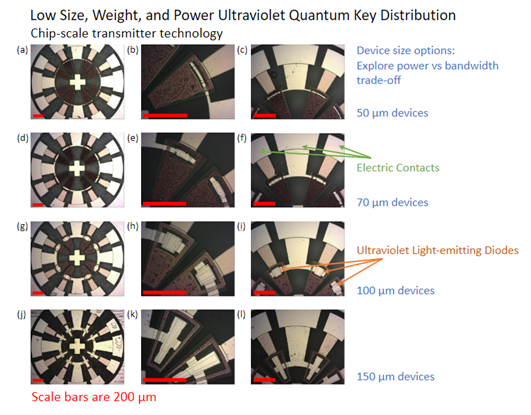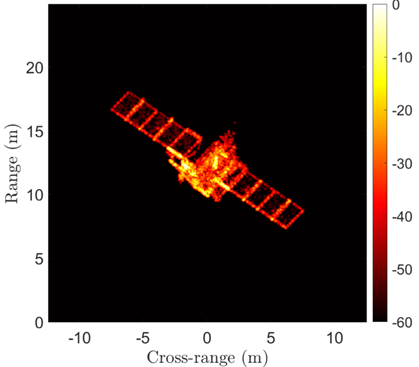Satellites have been in orbit for over 60 years, but we continue to seek ways to innovate the technology, resulting in better connectivity, communications, Earth observation and space sensors.
The following projects funded by the UK Space Agency’s Enabling Technologies Programme (ETP) aim to develop new or improved instruments in the field of satellites, sensors and communications. Our ETP grants each fund £250,000 towards high-risk, high-reward research to improve technology readiness levels.
CubeSats are an inexpensive form of nanosatellite that have gained traction thanks to their standardised design and versatility. With this rise in popularity comes an increased demand for CubeSat efficiencies, to maximise the payload and increase science capabilities.
One ETP-funded team at the University of Strathclyde is aiming to do just that with their, “Micro LEDs for Satellite Quantum Key Distribution” project.

Project Lead Daniel Oi explains:
“These images show arrays of micro light emitting diodes (microLEDs) operating in the ultra-violet (UV) region of the spectrum that can act as a source of quantum photonic states for quantum key distribution (QKD) between satellites.
“The shorter wavelength of UV allows the use of smaller transmission and receiver telescopes for a given free-space diffraction loss, hence may allow for more compact, lower-SWaP payloads for inter-satellite QKD, particularly suited to CubeSats.
“Additionally, the temperature insensitive nature of the spectral emission reduces thermal stabilisation requirements, lowering power and design constraints, as well as mitigating against side-channel information leakage, hence enhancing security.”
The project is currently at its midway point, with the University of Strathclyde having successfully designed and fabricated the first set of devices, and the University of Bristol performing preliminary integration activities with their experimental apparatus. Based on the data gathered during the first device tests, a second device run will refine the design for further characterisation of QKD performance.
This project team is a collaboration between the Department of Physics and Institute of Photonics, both at the University of Strathclyde, and the University of Bristol. Both universities are involved in the UK Quantum Communication Hub mission, SPOQC, to demonstrate satellite QKD from a CubeSat that is due to be launched in 2025, and the Canadian QEYSSat microsatellite mission. They have also collaborated on previous UK Space Agency projects as part of the National Space Technology Programme (NSTP) and National Space Innovation Programme (NSIP) to develop CubeSat QKD.
Meanwhile at the University of Birmingham, a team supported by ETP funding and led by Dr Leah-Nani Alconcel (associate professor at the School of Metallurgy and Materials) is developing antennae to monitor mechanical or surface condition of satellites directly from space in the project “Sub-Terahertz Inverse Synthetic Aperture Radar (ISAR) for monitoring of GEO assets – STAR”.

Dr Alconcel said:
“The STAR project by researchers in the Schools of Engineering and Metallurgy & Materials at the University of Birmingham has produced a first-of-its-kind metaheuristic simulator of radar images of orbiting spacecraft from a space-based platform.
“These high-resolution inverse synthetic aperture radar (ISAR) images are suitable for input into an AI-based inference model that can identify and track key features on the observed spacecraft. The system works without an external source of optical illumination and from aspect angles that cannot be accessed from ground-based platforms.
“The potential applications for this unique technology include on-orbit inspection and in-orbit servicing.”
The results of STAR promise positive commercial outcomes as the ISAM market continues to grow at a rapid rate, bolstering sustainability and the longevity of spacecrafts and satellites.
Wrapping up their ETP-funded project is Oxford Dynamics (OD), who have been exploring the viability of automotive radar systems for on-satellite detection of debris and other spacecraft, as part of its AI-based, multi-modal sensor Space Situational Awareness (SSA) framework, called The Great Eye.

Automotive radar systems offer an intriguing and attractive opportunity for reducing SSA costs as significant non-recurring engineering (NRE) has been successfully completed on this type of sensor.
Automotive radars are characterised by being low cost, reliable and maintenance-free, with a small form-factor and the ability to operate under conditions of temperature extremes and vibration (and humidity).
Mike Lawton, from the OD team, said:
“The primary challenge under The Great Eye project was to explore if significant range extension of an automotive RADAR was feasible for space applications.
“The project concluded that it is indeed feasible, however with technical trade-offs required to improve size of object detected, range performance and field of view. The project also progressed OD’s novel AI-based image captioning: the ability for AI to describe a scene in the way a human analyst would.”
A roadmap to progress from this feasibility study to in orbit demonstration was also produced.
Finally, Ultima Forma is working with various partners in industry using their extra-thin metal layering technology in a proof-of-concept ETP project, “Electroformed modular Q-band waveguide assemblies”, which aims to produce prototype Q-band waveguides for satellites by a novel modular electroforming process.
Building on an earlier concept feasibility study, Ultima Forma is developing the manufacturing process for Q-band waveguides, including the modular components, flexible sections and joining technology, to produce configurable waveguide assemblies. These will be evaluated and tested for radio frequency (RF) performance by Airbus Defence and Space.
The proof-of-concept will unlock the potential for a cost-effective Q-band waveguide manufacture process, accelerating UK satellite competitiveness in this emerging market.
Ultima Forma is also making use of its’ electroforming capabilities to support projects aiming to decarbonise the aerospace sector: watch this space for updates coming soon!
Look out for our final blog post in the ETP series, which will focus on a variety of novel instruments and technologies that haven’t yet been captured in our previous topics (lasers and aiding exploration).
Leave a comment